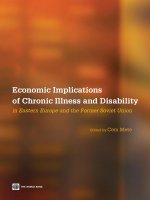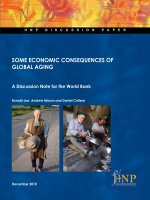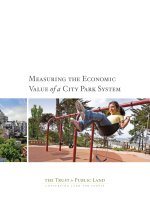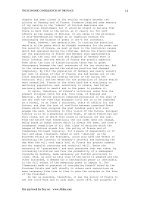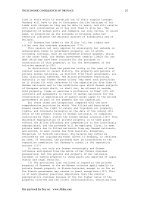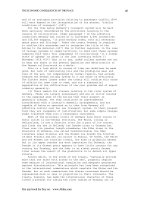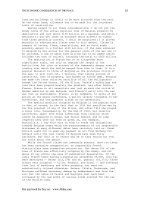The economic consequences of the war west germanys growth miracle after 1945
Bạn đang xem bản rút gọn của tài liệu. Xem và tải ngay bản đầy đủ của tài liệu tại đây (21.06 MB, 294 trang )
i
The Economic Consequences of the War
The ‘German Question’ dominated much of modern European history.
In 1945, Germany was defeated and conquered, yet World War II did
not destroy the foundations of her economic power. Dr Tamás Vonyó
revisits Germany’s remarkable post-war revival, tracing its roots not to
liberal economic reforms and the Marshall Plan, but to the legacies of
the war that endowed Germany with an enhanced industrial base and
an enlarged labour force. He also shows that Germany’s liberal market
economy was in reality an economy of regulated markets, controlled
prices, and extensive state intervention. Using quantitative analysis
and drawing on a rich historiography that has remained, in large part,
unknown outside of Germany, this book reassesses the role of economic
policy and the importance of wartime legacies to explain the German
growth miracle after 1945 and the sharply contrasting experiences of
East and West Germany.
Tamás Vonyó is Assistant Professor of Economic History at Università
Commerciale Luigi Bocconi, Milan. He has written extensively on economic growth in post-war Europe and Germany’s economic development during World War II.
ii
iii
Cambridge Studies in Economic History
Editorial Board
Paul Johnson
University of Western Australia
Sheilagh Ogilvie
University of Cambridge
Avner Offer
All Souls College, Oxford
Gianni Toniolo
Universita di Roma ‘Tor Vergata’
Gavin Wright
Stanford University
Cambridge Studies in Economic History comprises stimulating and accessible economic history which actively builds bridges to other disciplines. Books in the series will illuminate why the issues they address
are important and interesting, place their findings in a comparative context, and relate their research to wider debates and controversies. The
series will combine innovative and exciting new research by younger
researchers with new approaches to major issues by senior scholars. It
will publish distinguished work regardless of chronological period or
geographical location.
A complete list of titles in the series can be found at: www.cambridge
.org/economichistory
iv
v
The Economic Consequences
of the War
West Germany’s Growth Miracle after 1945
Tamás Vonyó
Bocconi University
vi
University Printing House, Cambridge CB2 8BS, United Kingdom
One Liberty Plaza, 20th Floor, New York, NY 10006, USA
477 Williamstown Road, Port Melbourne, VIC 3207, Australia
314–321, 3rd Floor, Plot 3, Splendor Forum, Jasola District Centre,
New Delhi – 110025, India
79 Anson Road, #06-04/06, Singapore 079906
Cambridge University Press is part of the University of Cambridge.
It furthers the University’s mission by disseminating knowledge in the pursuit
of education, learning, and research at the highest international levels of
excellence.
www.cambridge.org
Information on this title: www.cambridge.org/9781107128439
DOI: 10.1017/9781316414927
© Tamás Vonyó 2018
This publication is in copyright. Subject to statutory exception
and to the provisions of relevant collective licensing agreements,
no reproduction of any part may take place without the written
permission of Cambridge University Press.
First published 2018
Printed in the United Kingdom by Clays, St Ives plc
A catalogue record for this publication is available from the British Library.
Library of Congress Cataloging-in-Publication Data
Names: Vonyó, Tamás, 1979– author.
Title: The economic consequences of the War : West Germany’s
growth miracle after 1945 / Tamás Vonyó.
Description: Cambridge, United Kingdom; New York, NY: Cambridge
University Press, 2018. | Series: Cambridge studies in economic history |
Includes bibliographical references and index.
Identifiers: LCCN 2017046242 | ISBN 9781107128439 (hardback)
Subjects: LCSH: Economic development – Germany (West) |
Germany (West) – Economic conditions. | Germany (West) –
Economic policy. | Germany – History – 1945–
Classification: LCC HC286.5.V65 2018 | DDC 338.943–dc23
LC record available at />ISBN 978-1-107-12843-9 Hardback
Cambridge University Press has no responsibility for the persistence or accuracy
of URLs for external or third-party internet websites referred to in this publication
and does not guarantee that any content on such websites is, or will remain,
accurate or appropriate.
vii
To my father, Édesapámnak
viii
ix
Contents
List of Figures
List of Tables
Preface
List of Abbreviations
Introduction
1 The Audit of Defeat: Initial Conditions
1.1 Production Capacity
1.2 Population and Living Conditions
1.3 The Economics of Allied Occupation
2 The Economic Geography of Post-War Dislocation
2.1
2.2
2.3
2.4
The Urban Housing Shortage and Its Consequences
Data on Regional Economic Development
The Economic Impact of Wartime Destruction
The Economics of Urban Reconstruction
3 Growth Accounts for West German Industry
3.1
3.2
3.3
3.4
Industrial Output and Factor Inputs
Industrial Labour Productivity
Total Factor Productivity
The Limits of Post-War Growth
4 Made in Germany: The Post-War Export Boom
4.1
4.2
4.3
4.4
Alternative Explanations
The Geography of German Exports
The Commodity Structure of German Exports
The Export Boom and Industrial Expansion
5 Managing the Miracle: Economic Policy
5.1
5.2
5.3
5.4
1948 and the Social Market Economy
The Marshall Plan in Germany
Fiscal Policy: From Contraction to Expansion
Monetary Policy: From Expansion to Contraction
page xi
xiii
xv
xix
1
19
22
31
41
52
56
61
69
76
87
89
97
101
107
129
131
145
163
169
173
175
190
203
211
ix
x
x
Contents
Conclusions
219
Appendices
Bibliography
Index
227
241
267
xi
Figures
1.1 The territorial losses and division of Germany after
World War II
1.2 The population of the largest West German cities
in 1939 and 1946
1.3 Indexes of net industrial production in the western
occupation zones
1.4 The growth of money supply and sovereign debt
in Nazi Germany
2.1 Gross fixed investment in the West German economy,
1936–1943
2.2 Regional levels of industrialisation and unemployment
as of 30 December 1950
2.3 The rate of unemployment and industrialisation in
large cities as of 13 September 1950
2.4 Regional variation in housing damage and the settlement
of expellees
2.5 The share of expellees in non-agricultural employment
on 13 September 1950
2.6 The share of urban and rural counties in total and
industrial turnover
2.7 Average hourly wages for male workers in West German
industry in 1957
2.8 Average weekly working hours for male workers
in West German industry
3.1 The composition of net industrial production
in 1950 prices
3.2 The industry origins of labour-productivity growth
3.3 Growth potential derived from spare capacities in West
German industry
3.4 Reconstruction growth in West German industry
page 21
35
43
48
53
54
55
73
78
81
85
85
93
102
108
111
xi
xii
xii
List of Figures
3.5 Rebalancing industrial capacities during the
reconstruction phase
3.6 The composition of industrial employment in Germany
during World War II
3.7 The employment structure of East German refugees
in West Germany in 1961
4.1 The development of export and import prices and the
Terms of Trade
4.2 The growth of West German exports and imports
in current prices
4.3 The growth of West German exports and imports
in 1962 DM prices
4.4 The expansion of the German Empire between
1937 and 1942
4.5 The geographical distribution of German/West German
exports
4.6 The reorientation of German exports within Europe,
1936–1942
4.7 The diversion of West German exports after 1950
4.8 The share of major product groups in German/West
German exports
4.9 The share of the federal states in West German exports
5.1 Investment programs financed by ERP assets by sector
between 1949 and 1952
5.2 The value of ERP aid to the main recipient countries
in the fiscal year 1949–1950
5.3 The overall fiscal surplus and total government spending
as a share of GNP
5.4 Total housing construction and the share of social
housing in the Federal Republic
113
117
125
135
137
138
147
148
155
161
166
168
196
200
204
209
xiii
Tables
1.1
Expellees and refugees in the West German
population after World War II
page 35
2.1 The wartime destruction of urban housing in West
Germany
57
2.2 Population and industrial employment in West Germany
and West Berlin
64
2.3 Total turnover in West Germany and West Berlin in
million 1950 DM
66
2.4 The development of urban and rural counties in West
Germany, 1939–1950
70
2.5 The development of urban and rural counties in West
Germany, 1950–1961
80
3.1 Index of net industrial production
90
3.2 Index of gross industrial capital stock
94
3.3 Index of annual labour hours
96
3.4 Index of industrial labour productivity
98
3.5 Decomposing labour-productivity growth in West
German industry
101
3.6 Index of capital intensity in West German industry
105
3.7 Growth accounts for West German industry 1938–1970
105
3.8 Annualised growth accounts for West German industry,
1950–1970
106
3.9 The regional distribution of gross value-added in
German industry in 1936
109
3.10 Domestic and international trade in industrial products
in 1936
110
3.11 The number of skilled workers in West German industry
120
3.12 The skilled-labour ratio of the industrial workforce
122
4.1 German trade with continental Europe during World War
II in million RM
154
4.2 Country shares in total German/West German exports
159
xiii
xiv
xiv
List of Tables
4.3 Correlations explaining the commodity structure of
West German industrial exports
4.4 Correlations testing for export-led growth in West
German industry
5.1 Foreign aid in the Western occupation zones and the
Federal Republic
5.2 Fiscal stimuli of the federal government and monetary
policy in the 1950s
A1.1 Estimated average tax rates on total turnover
in the federal states
A2.1 Estimates of gross capital stock in West German industry
at the start of each year: Machinery and equipment
A2.2 Estimates of gross capital stock in West German industry
at the start of each year: Structures
A3.1 Levels of employment in West German industry between
1938 and 1950
A4.1 The commodity structure of German/West German
exports in million 1950 DM
168
171
194
216
228
231
233
236
238
xv
Preface
Werner Abelshauser opened his seminal monograph on the history of
the West German economy since the end of World War II with the statement that ‘the history of the Federal Republic of Germany is above all its
economic history’ (Abelshauser 1983, 8). This interpretation is reflected
in both the national and international historiography of the period. The
economic revival of the nascent German state during the 1950s from its
devastation a decade earlier has been considered its most remarkable
achievement. The earliest contributions Germany made to the rebuilding
of Europe and to European integration were fundamentally economic.
However, this argument can be easily turned around, for the resurgence of the German economy from the desolate state caused by defeat,
destruction, and dislocation was shaped by historical legacies, the long
shadows of the war and the conditions it had left behind. As Joel Mokyr
(1990) wrote, ‘In economics, history is destiny’.
The Economic Consequences of the War revisits a major debate in German
historiography and the economic history of modern Europe. It reveals
the wartime origins of the post-war economic success that stunned contemporaries in Germany and captivated so many economists and historians. It is a comprehensive study of the quantitative evidence on both the
domestic and external determinants of industrial development in West
Germany in the quarter century that followed the most decimating war in
modern history. That the German growth miracle, the Wirtschaftswunder,
was a reconstruction phenomenon is not a novel proposition. It was pioneered by the Hungarian economist Ferenc Jánossy (1969) and brought
to the attention of economic historians by Matthias Manz (1985) and
Werner Abelshauser (1975, 1983). My aim has been to add quantitative substance to this literature and to synthesise the findings of a rich
scholarship that has remained, in large part, unknown to international
and non-specialist audiences. The study of detailed regional and industry statistics will demonstrate to the reader that one cannot explain the
dynamics of post-war economies without understanding the role of economic geography and production structure, which have been neglected
xv
xvi
xvi
Preface
in the historiography. By filling in these gaps, my work supports an interpretation of the reconstruction theory that is more compatible with the
historical evidence, and which also places the role that economic policy
played in the Wirtschaftswunder into a new context.
After 1945, Germany was no longer the primary source of military
threat in Europe but soon re-emerged as the leading industrial power
on the continent. Since the economic foundations of German power
are commonly believed to be rooted in a uniquely German approach
to economic management, which many continue to see as the product
of the post-war consensus, a renewed look at this era is highly topical in
times when Germany is once more looked up to as the leader of Europe
and the beacon of stability on a continent in crisis. In such a light, this
monograph shall be of interest to a wider public, even though it focuses
on a specific episode of post-war history and even though the aim of the
enquiry was to provide an in-depth introspection into the dynamics of
post-war economic growth.
The Economic Consequences of the War has been my long-term project
and is the outcome of a decade of research. It builds on two dissertations
that I wrote in the course of my graduate and doctoral studies. Both
have received acclaim; they were awarded the Feinstein Prize for the best
graduate dissertation in economic and social history at the University of
Oxford in 2008 and the dissertation prize of the International Economic
History Association in 2012 respectively. Part of the material presented
and discussed in the chapters has been used in research papers published in peer-reviewed international journals, including three articles in
the European Review of Economic History between 2008 and 2014 and a
contribution to the German economic history yearbook, the Jahrbuch für
Wirtschaftsgeschichte, in 2014. The findings of these analytical investigations are integrated into Chapters 2 and 3, but the book is much more
than the reprint of my thesis or the collection of my articles. It is the
synthesis of the research I have conducted for many years and describes,
in great detail, the contribution of this research to the vast literature that
has emerged on the topic.
The monograph is the work of not just a scholar but also a pupil of
economic history. Therefore, an exhaustive list of acknowledgements and
expressions of due gratitude would be almost as voluminous as the book
itself. Most certainly, it could not have been written without the benefit
of my former supervisor, Oliver Grant, to whom I am indebted for his
astute guidance, his informed comments, and his unwavering personal
support. I must thank my Oxford professors, especially Avner Offer, Jane
Humphries, and Knick Harley, for they were a constant source of inspiration and my guides into the art of economic history. Mark Spoerer
xvii
Preface
xvii
provided vital support during my first lengthy fieldwork in Berlin in
2008, which was financed by a Scatchered European Scholarship from
Oxford. Matthias Beer hosted me in Tübingen twice and helped me
understand the complexities of post-war displacement in Germany. My
examiners, Nicholas Dimsdale and Albrecht Ritschl, offered invaluable
advice, worth a great deal throughout my postdoctoral career. Albrecht
has become one of my best colleagues and collaborators in the profession. Material from our joint work is included in this monograph, in the
final section of Chapter 3. Herman de Jong, who gave me my first job and
supervised my postdoctoral research at Groningen University, and other
distinguished colleagues of the Groningen Growth and Development
Centre helped me expand my skills in quantitative analytical methods,
in the fields of both productivity analysis and growth accounting. My
research on the theme of this book has been presented at conferences
of the Economic History Association, the Economic History Society,
the European Historical Economics Society, and the European Social
Science History Conference, as well as on congresses of the International
Economic History Association, and at numerous research seminars.
I must express my most sincere gratitude to all of my colleagues who
have shown interest in my work and made constructive comments on
how to enhance the fruits of my efforts.
The monograph itself could not have been completed without the help
of others. My editor at Cambridge University Press, Michael Watson,
provided professional guidance throughout the process. The series
editors and the external reviewer helped me improve the manuscript.
Their scholarly input is very much part of this book. The chapters that I
wrote last were completed in Berlin and London, where invitations from
Nikolaus Wolf and Albrecht Ritschl gave me access to libraries and archival resources that I still had to consult. Jaap Sleifer and Jonas Scherner
kindly let me use the data they had compiled in their earlier work at the
Bundesarchiv in Berlin-Lichterfelde. Tobias Vogelgsang has offered to let
me read and cite his yet unpublished dissertation. Throughout my work,
I have been assisted by the endowments and financial support of Bocconi
University and the Dondena Centre for Research on Social Dynamics
and Public Policy. Lastly, and most importantly, I must thank my father,
to whom I dedicate this book. Born on the very day when World War II
ended in my native Hungary and growing up in the misery that characterised post-war life throughout Europe, he became a professor of history and a passionate educator. Without his love and support, I would
not be half the man or the scholar that I am today.
xvii
xix
Abbreviations
ASE
Amt für Stahl und Eisen (Verwaltung für
Wirtschaft des Vereinigten Wirtschaftsgebiets)
Außenhandel
Der Außenhandel der Bundesrepublik
Deutschland
BArchBundesarchiv
BDI
Bundesverband der Deutschen Industrie
BdL
Bank deutscher Länder
BW
Baden-Württemberg
CAP
Common Agricultural Policy
COCOM
Coordinating Committee for East–West Trade
DGB
Deutscher Gewerkschaftsbund
DIW
Deutsches Institut für Wirtschaftsforschung
DMDeutsche Mark
DQP
Differentiated Quality Product
ECA
European Cooperation Act
ECSC
European Coal and Steel Community
EEC
European Economic Community
EFTA
European Free Trade Agreement
EPA
European Payments Agreement
EPU
European Payments Union
ERP
European Recovery Program
EStGEinkommensteuergesetz
FDI
Foreign Direct Investment
FSE
Fachstelle Stahl und Eisen der Verwaltung für
Wirtschaft des Vereinigten Wirtschaftsgebiets
GARIOA
Government and Relief in Occupied Areas
GATT
General Agreement in Tariffs and Trade
GDR
German Democratic Republic
IARA
Inter-Allied Reparation Agency
IndBRD
Die Industrie der Bundesrepublik Deutschland
JEIA
Joint Export–Import Agency
KfW
Kreditanstalt für Wiederaufbau
xix
xx
newgenprepdf
xx
Abbreviations
Kultusminister
konferenz
Länderrat
Ständige Konferenz der Kultusminister der
Länder in der Bundesrepublik Deutschland
Länderrat des Amerikanischen
Besatzungsgebiets
MCC
Ministerial Collecting Center
NRW
North Rhine-Westphalia
OEEC
Organisation for European Economic
Cooperation
OEED
Overall Economic Effects Division (OMGUS)
OMGUS
Office of Military Government for
Germany (US)
POWPrisoner of war
Reichsamt
Reichsamt für Wehrwirtschaftliche Planung
RMReichsmark
RP
Rhineland-Palatinate
Sachverständigenrat Sachverständigenrat für Begutachtung der
gesamtwirtschaftlichen Entwicklung
SchH
Schleswig-Holstein
SME
Social Market Economy
StatBRD
Statistik der Bundesrepublik Deutschland
StatDR
Statistik des Deutschen Reichs
TFP
Total Factor Productivity
UNRRA
United Nations Relief and Rehabilitation
Administration
USSBS
United States Strategic Bombing Survey
Wissenschaftlicher
Wissenschaftlicher Beirat beim Bundesminis
Beirat
terium für Wirtschaft
1
Introduction
This monograph revisits a major topic in the economic history of modern Germany. The quarter century that followed World War II has been
enshrined in collective memory as perhaps the most remarkable era
of macroeconomic stability and social progress in the Western world
(Milward 1992). In striking contrast with the period that Churchill
(1948) famously labelled the Second Thirty Years War, this ‘golden age
of economic growth’ (Crafts 1995) was marked by an amalgamation of
rapid technological advancement, widening prosperity, and sound governance. Among that of all the Western industrialised nations, the economic performance of West Germany during these decades was arguably
the most impressive, especially against the backdrop of military defeat
in 1945 and the disintegration in the years that followed. Astonished
contemporaries thought of witnessing an ‘economic miracle’, and the
notion of the Wirtschaftswunder found resonance in subsequent academic
research at home and abroad. World War II inflicted an unprecedented
scale of material damage upon the defeated, demoralised, and in large
part displaced population of the Third Reich. The devastating impact of
strategic bombing has been documented in both German and international historiography (see Mirzejewski 1988; Eichholz 1999; Friedrich
2002; and Tooze 2006). On the day of the unconditional surrender of all
German land, sea, and air forces, not a single bridge spanned the Rhine,
and industrial production had come to a standstill with the destruction of the transport system. Demolished buildings and roads clogged
the urban landscape and scenes of human misery were impossible to
avoid. Not surprisingly, contemporary observers were astounded by the
rapidity with which the German economy propelled itself forward, akin
to a phoenix rising from ashes.
The earliest accounts of the Wirtschaftswunder were in accord that the
West German revival began in 1948 and that it was engineered by the
combination of radical economic reforms and Western economic aid.
The ‘structural break hypothesis’, as this institutional view has been
referred to in German historiography, attributed an instrumental role to
1
2
2
The Economic Consequences of the War
the Social Market Economy in the success of post-war reconstruction.
Firmly in line with the ‘Freiburg school’ of liberal economics that dominated the political philosophy, even if not always the policy praxis, of
post-war West German governments, this interpretation posited that the
institutional framework of the Federal Republic was fundamentally different from that of Imperial Germany, Weimar, and the Third Reich, for
it had been built on the ruins of a vanquished and devastated country.1
Wallich (1955) presented the seminal critique of this traditional view by
identifying favourable supply-side conditions and the reintegration of the
Bonn Republic into the international economic order as ‘the mainsprings
of the German revival’. However, the notion of Ground Zero (Stunde
Null) was still very much present in the subsequent writings of Hoffmann
(1965) and Roskamp (1965). They believed, alongside many others, that
the German growth miracle was driven by extraordinary levels of investment that replaced the outdated and largely destroyed productive arsenal
of German industry, and thus they suggested an important catalysing
role for economic policy.
A new wave stormed into the German historiography of the post-war
era after 1966, when Jánossy (1969) proposed an inspiring theory to
explain the economic miracles that the world had witnessed since 1945.
In a nutshell, the ‘reconstruction thesis’, as the work of the prominent
Hungarian economist has been referred to in the international literature,
proposed that war-shattered economies would automatically recover to
their long-run productive potential following the cessation of hostilities
and the removal of the most immediate impediments to normal market
activity. Wartime destruction and distortions in the efficient allocation of
productive forces promised high returns on future investment, prompting accelerated capital accumulation in the reconstruction phase. Once
the economy had returned to its long-run growth path, the rate of economic growth would abate abruptly and dramatically. The potential for
further growth in productivity would depend solely on improvements in
labour qualifications and technical knowledge.
The Jánossy thesis was published at a critical juncture during the first
economic recession Germany had endured since the first years after
the war, which signalled the end of the reconstruction period, but the
role of reconstruction dynamics in post-war growth is, in fact, a much
older notion. John Stuart Mill had already talked about a vix mediatrix
naturae that lifted nations out of their devastation and restored them
to their normal conditions (cited in Abelshauser 2004, 282). Modern
1 For a general summary of this literature, see Klump (1985), 23–5 and Borchardt (1991),
99–103.
3
Introduction
3
economists, including Milton Friedman, remarked on this phenomenon, claiming that the wartime dislocation of economies can give rise to
extraordinarily high growth rates in the post-
war period (Friedman
quoted in Klein 1961, 291). Jánossy formalised this concept and applied
it specifically to explain the growth miracles of his age. Abelshauser
(1975, 1983), Manz (1985), and Borchardt (1991) introduced his pioneering work into the German literature. After two world wars and two
severe interwar slumps, they argued, an ‘accumulated developmental
deficit made it possible, as long as it had not been fully absorbed, to
achieve significantly higher growth rates of per capita national product
than prior to the onset of [the above] crises’ (Abelshauser 1983, 92).
In turn, as the growth potential inherent in post-war reconstruction
had been exhausted by the early 1960s, the ensuing slowdown of the
West German economy was interpreted as the necessary outcome of re-
convergence to an established growth path. This interpretation left little
room for the political and economic reforms after 1948 as the propellers
of the Wirtschaftswunder. Instead it introduced an economic dimension
to the emerging revisionism in German historiography, exhibited most
notably in the works of Fischer (1969, 1979) and Wehler (1973, 1975),
that placed growing emphasis on historical continuities in the development of German society over the discontinuities brought by the major
calamities of the early twentieth century.
The international scholarship on post-war growth also recognised the
relevance of the Jánossy model (see Carlin 1996 and Crafts and Toniolo
1996, among others). Cliometric studies have confirmed the presence
of a powerful reconstruction dynamic in Western industrialised nations
during the 1950s (Dumke 1990; Wolf 1995; Temin 2002; Eichengreen
and Ritschl 2009). My contributions to this literature have shown that
the relative growth performance of member states of the Organisation
for Economic Co-operation and Development (OECD) reflected, above
all, the scale of post-war dislocation until the late 1960s (Vonyó 2008)
and that the falling behind of Eastern European economies in the early
post-war era was, in large part, due to significantly stronger reconstruction dynamics in the West (Vonyó 2017). My econometric analysis has
confirmed that the reconstruction thesis has particularly strong predictive power for the West German growth record. The reconstruction
effect was more persistent than it seemed to have been on the basis of
earlier studies. The absorption of this unique growth potential, in turn,
caused the sharp slowdown of the fastest-growing Western economies
in the early 1970s. Nations shattered by war, Germany included, maintained their war-induced potential for high productivity growth even
after their industrial and public infrastructure had been rebuilt and the


